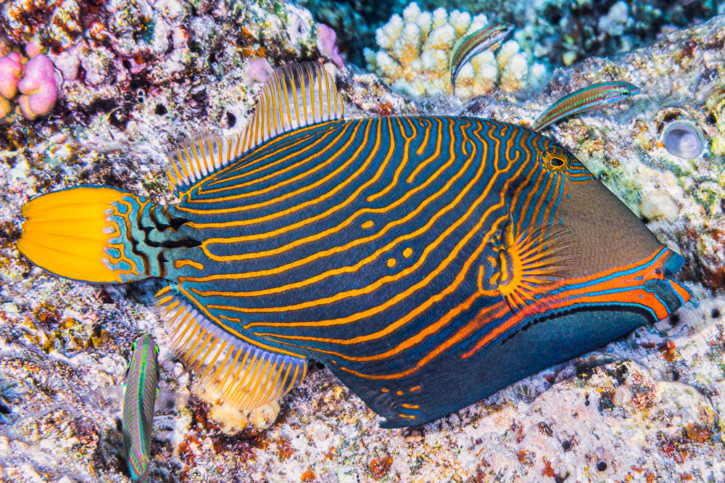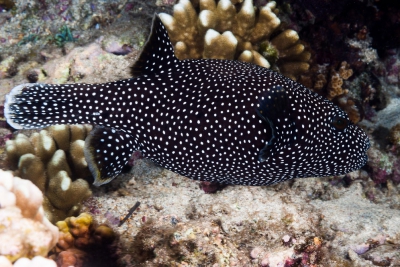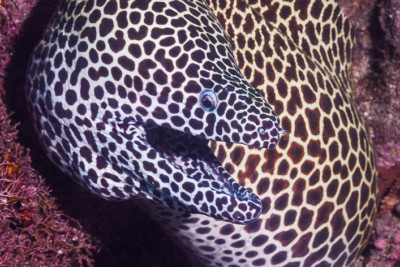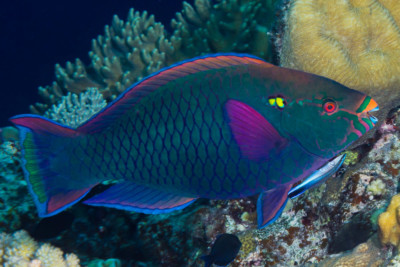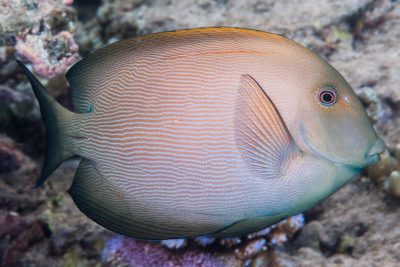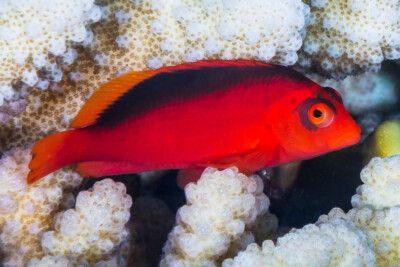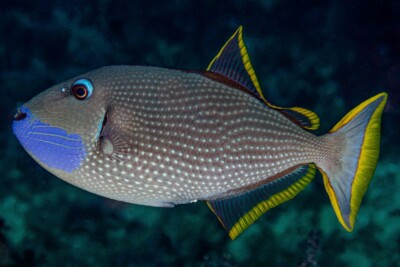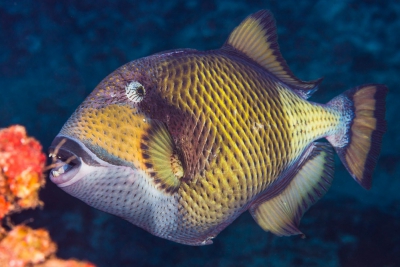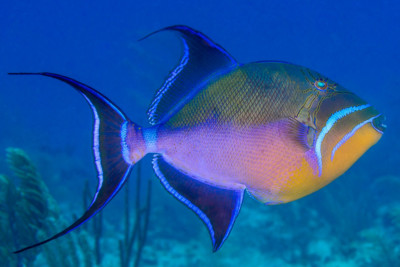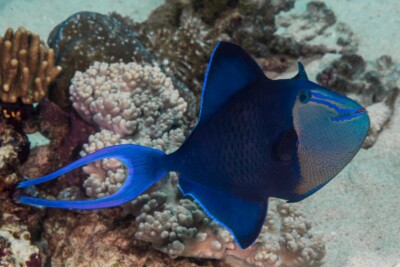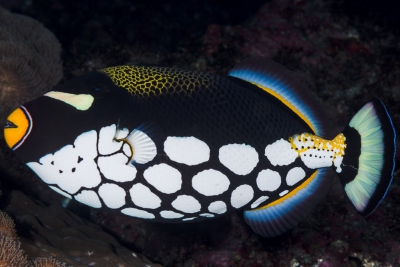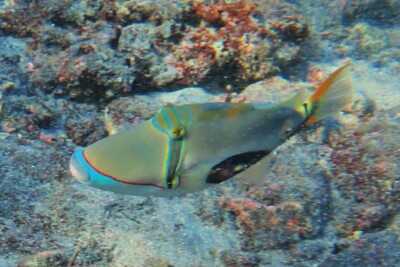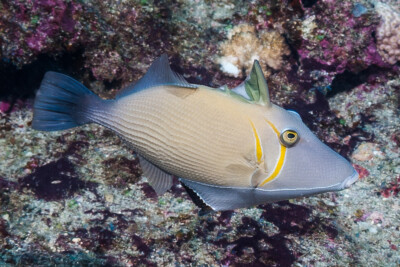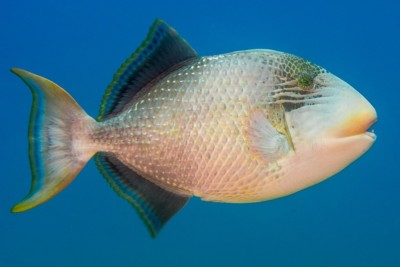orange-lined triggerfish
| Scientific name | Balistapus undulatus |
|---|---|
| Descriptor | Park |
| Year of description | 1797 |
| IUCN category (World) | LC |
| Family | Balistidae |
| Genus | Balistapus |
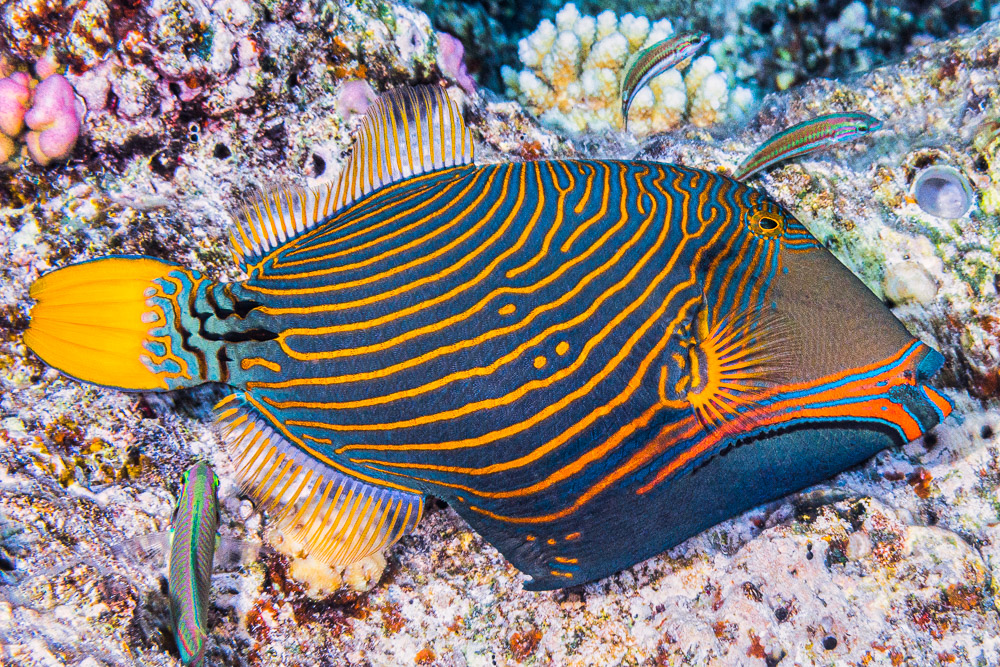

Introduction
The Balistapus undulatus, or orange-lined triggerfish, is a fish that lives in the tropical waters of the Indo-Pacific. It is found along the East African coast, from the Red Sea to South Africa, and can be discovered in the Marquesas and Tuamoto Islands. To the north, it is found up to the Sea of Japan, and to the south, to the Great Barrier Reef and New Caledonia.
This territorial fish frequents calm coral-rich areas of lagoons and coastal reefs.
This species is a large predator of sea urchins, it also feeds on a wide variety of benthic animals.
Who is it?
Morphology
-
Type
-
Average size26 cm
-
Maximum size30 cm
-
Longevity10 year
-
Patterndiagonal stripes
-
Type
-
Average size26 cm
-
Maximum size30 cm
-
Longevity10 year
-
Patterndiagonal stripes
How to recognize This fish ?
The orange-lined triggerfish is a fish that can reach up to 30 centimeters in length. It is easily recognizable thanks to its very distinctive coloration. It has a flat, trapezoidal body covered in large scales.
Its coloration is mainly greenish or brown, with several diagonal orange lines running across its body. These lines are absent on the cheeks of adult individuals.
The slightly rounded caudal fin is also orange, and a large round black spot covers most of its base.
Like other triggerfish, it has a dorsal fin on its back that is formed of three spines. The first one, long and sharp, can be locked in a vertical position, even after the fish's death. This mechanism is used as a deterrent for predators but can also be used to sleep peacefully in narrow cavities, where it unfolds its fin to avoid being carried by currents.
The second dorsal fin is symmetrical to the anal fin, while the pelvic fins form a single spine.
Two black lines formed by the scales covering the body are visible on the caudal peduncle, these lines have small spines.
Compared to the rest of its body, it has a small mouth with sharp teeth that allow it to break the shells of its prey.
Sexual dimorphism
Males grow larger than females.
Behaviour & Life cycle
-
dietcarnivorous
-
Sociabilitysolitary
-
territorialNo
-
Way of livingdiurnal
The orange-lined triggerfish is a rather solitary fish that is rarely found in groups.
It is a territorial species, generally of rather calm temperament, although it can be aggressive towards other species, especially during the breeding season.
These hunters mainly feed on various benthic organisms such as algae, mollusks, crustaceans, sponges, other fish, and sea urchins.
At night, they sleep in crevices and cavities, where they block themselves by raising their dorsal fin.
Reproduction
-
Reproductionovovivipare
The orange-lined triggerfish is an ovoviviparous fish. The male descends to the bottom, bends its body laterally by beating its dorsal and caudal fins to dig a nest in the sand.
The eggs are deposited in the nest, in a single spongy cluster. The spawning is guarded until hatching by one or sometimes both adults. Hatching occurs during the night.
Harmless species
This species does not pose a particular danger to humans if encountered in its natural environment.
Origin and distribution

What is its habitat?
Natural environment characteristics
-
Temperature25 - 29 °C
-
Depth2 - 50 m
Biotope presentation
The orange-lined triggerfish is most commonly found in calm waters at low depths, generally less than 50 meters. However, it is not impossible to find them at other depths.
It is found in coral-rich areas where the ground is usually made up of sand and rocks.
Species of the same biotope
To go further
Sources & Contributions
Participation & Validation
The Fishipedia team and specialist contributors are committed to providing high-quality content. However, although the information comes from scientific sources or testimonials from specialists, the cards may contain inaccuracies.

Silvia Gomez
Translation
Translation done with the valuable contribution of our translators, who make this information available to a wider audience. We sincerely thank them for their commitment.
Scientific partners
Tags
Species of the same family
Species of the same biotope
